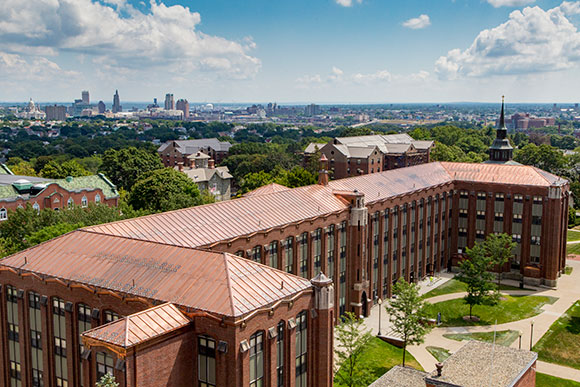The Many Colors of Copper

The new copper roof on Aquinas will turn many colors before it settles into the greenish blue patina we are accustomed to seeing on our college buildings and why is that you may ask. It is all about the natural weathering process of copper.
The natural weathering of copper to the characteristic blue-green or gray-green patina is a direct consequence of the mild corrosive attack of airborne sulfur compounds. In the atmosphere, these compounds combine with water vapor to form dilute oxidizing acids which react with copper surfaces.
As natural weathering proceeds, the metal exposed to the atmosphere changes in hue from the natural salmon pink color through a series of russet brown shades to light and dark chocolate browns and finally to a dark, dull slate gray or dull black from which the ultimate blue-green or gray-green patinas emerge. The initial transition from the natural salmon pink color to the russet browns stems from the formation of copper oxide conversion films on the exposed metal surface.
During the initial weeks of exposure, particularly in a humid atmosphere or in areas of frequent rainfall, radical color changes often take place with iridescent pinks, oranges and reds interspersed with brassy yellows, blues, greens and purples. These sometimes shocking color variations result from the initial formation of the oxide surface films which are so thin that rainbow-hued interference colors are seen. As the natural oxide film builds in thickness during continued exposure, the interference colors fade and are replaced by relatively uniform russet brown shades.
Due to varying fabricating procedures, some mills may coat coiled or flat sheet stock with a thin coat of anti-stain oil film. This film may give rise to dark purple or black surface colorations soon after installation and exposure. This is a temporary color phase caused by the thin oil film, which is quickly washed off by rain allowing the natural weathering of copper to proceed.
At times, there is concern with regard to color variations during or immediately following installation of large expanses of copper roofing or flashing. Such color variations are common and usually transient, tending finally to disappear as natural weathering proceeds. There are two principal sources for such color variations. One involves the storage conditions from the time of manufacture until the time of installation, while the second involves exposure conditions following installation. For both conditions, time is an important variable. Moisture is also a key factor.
Once a copper sheet is sheared to size in the mill, it is usually packed on pallets with a lining of moisture resistant kraft paper. For coiled stock, the copper is palletized and protected with “shrink-wrapped” polyethylene sheets and desiccants. When stored in a heated mill or warehouse, oxidation (the principal cause of color change) proceeds at a slow rate, since the environment is relatively dry and the copper surface is usually still coated with a thin film of rolling oil.
The first significant oxidation of the metal may occur when it is shipped or unpacked in a warehouse. In transfer, the cases may be exposed to rain, snow or high humidity conditions on open loading docks. Temperature changes can cause condensation within the paper wrappings inside the case. With moisture present on the metal surfaces, oxidation accelerates. Lengthy storage in unheated premises can, and often does, produce similar results.
Once received by the installing contractor, the metal may be subject to storage conditions which promote continuing slow oxidation. Fabricated goods may be further exposed to the weather during shipment to and storage at the construction site prior to installation. When installed, oxidation is continuous, but the rate fluctuates depending on the amount and duration of moisture present, temperature changes, contaminants in the air, the sunshine and even wind velocity.
Since installation of large expanses of copper roofing may take weeks or even months depending upon weather conditions and working conditions, color variations can and frequently do result from differing lengths of exposure and climatic changes. Natural weathering eventually produces a uniform appearance in every case.
All Completed Projects
John Sweeney
Senior Vice President Finance and Business
401-865-2299
Barbara Muriel
Senior Executive Assistant Finance and Business
401-865-2281





